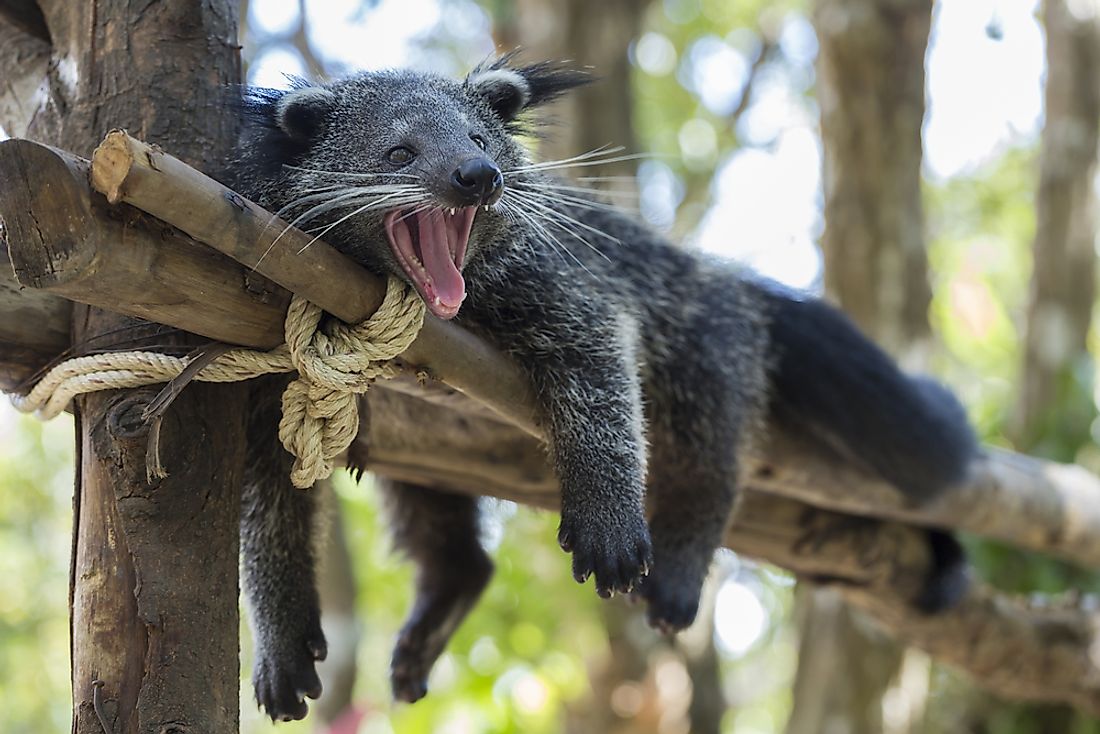Bearcat Facts - Animals of Asia

5. Physical Description
Also known as a "Binturong", the bearcat is actually related to neither bears nor cats, but is rather a member of the Viverridae Family, along with other civets and genets. Weighing up to 44 pounds (20 kilograms), the bearcat’s body length can reach 38 inches (96 centimeters), and its tail alone nearly doubles its total length, as they can be up to 35 inches (89 centimeters). Their fur is long and coarse, and usually black in color, though it may occasionally have gray tips. Their faces are a lighter color with long whiskers protruding from them, and there are long clusters of fur around their ears. One of the strangest things about the bearcat is that they are said to smell like "buttered popcorn".
4. Diet
Despite being in the Carnivora order, bearcats are omnivores, and in fact mainly eat fruits such as figs. Being excellent climbers with agile limbs, there is hardly anything they cannot reach in the trees, and they are even capable of opening fruit using only their toes. When they do hunt, however, their prey mainly includes smaller animals such as insects, birds, fish, and rodents. The bearcat’s hunting style resembles a cat stalking its prey from the branches. When the opportunity presents itself, the bearcat is not a picky eater and will scavenge and eat leftover carcasses. They will also not shy away from eggs, tree bark, shoots, or leaves.
3. Habitat and Range
The bearcat was once widely spread throughout Southeast Asia from China to India and all the countries in between, as well as many stretched out between there and into Oceania. However, due to deforestation, habitat degradation, the pet trade, the fur and meat trades, and poaching, it is now listed as a "Vulnerable" species under the IUCN Red List. Their population is still declining as the dense jungles they require grow even sparser each and every year, and, while there are no definitive population estimates for the species, they have become rare in all the countries they have traditionally been known to reside in. Although they are large and relatively slow, the bearcat does not have very many natural predators, apart from tigers, dholes, and snakes. This leaves humans and their activities as the largest threats to this species.
2. Behavior
Generally solitary creatures, the bearcat are not known to be territorial, but they are not social either and will avoid contact with each other. Mothers and their young may be seen together at certain times of the year, but it is not common. Bearcats use scent (their iconic "popcorn smell") and sound to communicate with one another, and will mark trees while they climb to keep others informed of where they are and have been. A happy bearcat will chuckle while an upset one will wail. They use their prehensile tails to help them climb, and when they are climbing down trees head first, they are able to rotate their hind legs backwards to better grasp the tree.
1. Reproduction
Bearcats mate throughout the year and do not have a peak season in which they breed. Females tend to breed twice a year. When they are "in heat" (estrus), they will make a mating call and purr to show that they are receptive. Their gestation period lasts around 3 months, and an average bearcat average litter will have 2 whelps (young ones), though litter sizes may range between 1 and 6. The male will occasionally stay with the female to care for their young until they are independent, whereas the female always will. Female bearcats become sexually mature at 30 months, whereas males mature a little faster and will be ready to mate at around 28 months of age.







